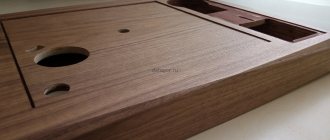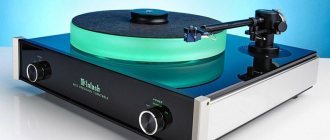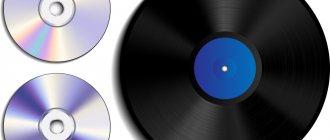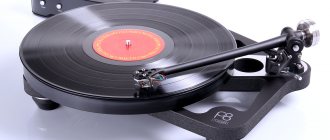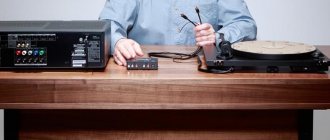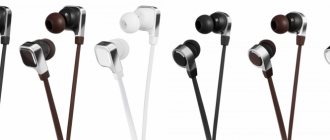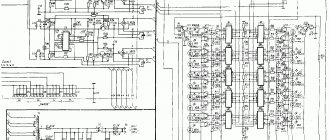Analog sound, not distorted by digital processing, has always attracted and continues to attract true music connoisseurs. It is vinyl records that allow you to enjoy true analog sound to the fullest, for which you need a vinyl record player or, as it is also called, an LP player. Vinyl records can rightfully be considered a symbol of the twentieth century; more than one generation of music lovers grew up on them, and vinyl players are the oldest signal sources of the Hi-Fi era.
Although at one time vinyl gave way to developing digital technologies, today many audiophiles are returning to it, rightly considering vinyl players to be the most advanced signal sources. Modern turntables are masterpieces of engineering art that can compete with high-tech devices in terms of build quality and precision.
What types of vinyl players are there?
Unlike gramophones from the time of our grandmothers, the player is often not a self-contained structure, but is part of the speaker system along with speakers, amplifiers and connectors.
Less common are the so-called
combines - players in which all the necessary components are built-in, including acoustics, amplifiers, connectors for connecting to a PC.
As a rule, the sound quality on them is noticeably lower than in full-fledged acoustic converters. Most of the authentic pickups of the past are out of order, so music lovers are puzzled by the question of how to choose a vinyl record player for the home that will be able to retain the liveliness and warmth of the sound. Let's look at the details and secrets of choosing a good turntable with examples of models included in the customer review rating.
Why vinyl sounds better
The high-quality sound of vinyl, which audiophiles and professional musicians talk about, is due to the peculiarities of audio signal conversion. Unlike other modern players, vinyl has an analog sound rather than a digital one. This doesn't make it any better from a professional point of view, since a digital signal is a more accurate representation of the recording than an analogue one. However, it is precisely this “inaccuracy” that provides the records with a more “live” and cozy sound.
Listening to vinyl is not just an attempt to remember the past and be a little nostalgic. This is an opportunity to expand your horizons and take a break from the usual digital sound. Records are worth attention just as much as discs or digital recordings are worth attention.
Choosing a vinyl player: subtleties and rules
The first step when choosing which turntable to buy is to become familiar with its basic structure.
The main components of the sound pickup system are:
- base - a solid base on which the working elements are placed;
- turntable - a disk on which a record is placed to be played;
- tonearm - the same movable handle that is installed on the track;
- the pickup head has a needle that slides along the track, picking up sound from the cells.
In addition to them, the player includes control buttons, including a start button, rotation speed selection, handle height adjustment, connectors for connecting speakers and a PC.
Pickup
The non-removable pickup eliminates the possibility of replacing it if it breaks without disassembling the device. This solution is used in cheap players. Expensive models are equipped with a removable pickup.
Head type
MM (moving magnet) is relatively cheap and easy to operate, providing good sound quality. Such heads are most common, therefore, there are no problems with choosing replacement needles.
MC (moving coil) is more expensive and more difficult to set up, but more accurately conveys all shades of sound (corresponds to the hi-res format). Therefore, such heads are used in elite players.
Important: when choosing a budget player, it is better to choose a device with a standard GZS mount. This will allow, if necessary, to replace a failed head and modernize (upgrade) the “turntable” by purchasing a cartridge of a higher class. Find out from the seller which manufacturers' gas stations are suitable for the selected device. The larger the list of manufacturers, the better.
Needle shape
A spherical stylus is a simple and cheap stylus that produces poor sound quality and greatly wears out the record.
Elliptical is an improved type of spherical needle. Compared to the previous version, this stylus reproduces high frequencies more accurately and is more gentle on the vinyl disc. Reasonable balance of price and quality.
Conical is a modernized version of the elliptical needle. The result is higher quality playback and less wear on the record. True, these advantages increase the price of a conical needle.
Linear is the most advanced option, producing the highest quality sound. The price of such a needle is appropriate.
Additionally
Tracking force - refers to the force of pressing the stylus onto the record. Experts note that pickups with less downforce are more gentle on the vinyl disc and thereby extend its service life. But this does not mean that they are better in all cases. The optimal amount of downforce is 1-2 grams. The downforce parameter is taken into account when replacing the pickup.
Output signal level – relevant if the player is connected to an external phono preamplifier.
Weight – affects the downforce setting. The weight of the pickup must be taken into account when replacing it.
Part of the system or harvester?
The main part of the players consists only of the sound pickup part - a table, a tonearm with a stylus and a control system. Acoustics, amplifiers, and other playback elements are connected separately. The phono stage and stylus cartridge may also not be included in the package.
The sound quality of such models is better, and there are more customization options. If you want not only to hear your favorite artist from 20-60 years ago in the original, but also to feel like a real DJ of the disco era, then it is better to choose component models.
One such example is the Pioneer PLX-500
with direct rotation drive. The kit includes a built-in phono preamplifier, a rotating curved tonearm 23.05 cm long, a pickup head cartridge weighing 9.5 g. A rotating disk for a record with a diameter of 33.2 cm - this diameter is enough for playing large gift releases. 3 rotation speeds are supported - 33 and 45 rpm according to the new standard, as well as 78 rpm for lovers of classic sound. The pickup is equipped with an anti-skating system that reduces media wear. The player can be connected to audio systems using composite connectors, as well as to a PC.
All-in-one system models are more compact, cheaper and do not require additional equipment. In this case, the sound quality will be inferior to system players. The choice of a combine becomes justified only in cramped living conditions or during frequent transportation.
This model is in the line of the American manufacturer Ion Audio - Ion Trio LP
. The turntable is produced in a wooden case, the kit includes a built-in phono preamplifier, acoustics, and a straight rotating tonearm with a head. The rotary disk rotates using a traditional belt drive. Like the previous model, it supports three rotation speeds. Automation is represented only by the auto-stop function. All types of audio connectors are supported, cables for which are supplied.
Tonearm
As with the base, the tonearm material must dampen extraneous vibrations and resonances.
Material
Aluminum is a durable and lightweight material with average anti-resonance properties. The optimal solution for most players.
Carbon is better than aluminum at handling resonances and is lighter in weight. A carbon tonearm is more expensive and is less common - in premium technology.
Type
Rotary - cheap and simple in design, but it is characterized by a tracking error (distortion) and a skating effect (displacement of the tonearm towards the center of the record). To combat these disadvantages, manufacturers are increasing the length of the tonearm and equipping turntables with an anti-skating function.
The vast majority of turntable models are equipped with a similar tonearm.
Tangential - does not have the disadvantages of a rotating tonearm, but will cost much more and is not suitable for playing deformed records (with a significant wave, curves). Found in high-end players.
Form
The tonearm can be straight or S-shaped . There is no consensus among audiophiles as to which tonearm shape is better. On the one hand, the straight tonearm is lightweight, on the other hand, the S-shaped model is longer, which has a positive effect on sound quality.
Therefore, a straight tonearm is better suited for lightweight entry-level cartridges, and an S-shaped one is better for heavier and stiffer cartridges that need significant tracking force. The choice of a specific option is determined by the individual preferences of the user, but novice music lovers should pay attention to a direct tonearm.
Effective Length - In theory, the longer the tonearm, the fewer tracking errors, but in practice, too much arm weight will negatively affect the clarity of the sound. That is why this parameter must be assessed in conjunction with the weight of the tonearm.
The standard tonearm length is 9 inches, but extended models of 10-14 inches are also available.
Weight – the lighter the tonearm, the less wear and tear on the stylus and vinyl disc.
Analog-to-digital converter (ADC) – converts an analog signal into a digital one. Such a device is necessary for recording music to a PC or USB flash drive.
ADC characteristics: bit depth and sampling frequency. The larger these parameters, the higher the quality of the digital recording and the smaller the difference between it and the analog original. Optimal bit depth and sampling frequency parameters for digitizing in Audio CD format: 16 bits and 44 kHz. There are also higher rates - 24 bits and 48 kHz.
Phono stage
The audio signal that is picked up by the stylus of the pickup head is itself weak. Therefore, it needs amplification and correction, for which phono stages are used. Professionals prefer models with removable phono stages - they can be replaced with better and more advanced ones. The price of such parts is quite expensive, in addition, they take up additional space, but without them you cannot assemble a professional music system.
An example of such models is Thorens TD 190-2
, a semi-professional base designed for self-assembly. The kit includes a straight tonearm with an Ortofon OMB 10 pickup, equipped with an anti-skating system. Unlike previous models, it uses full automation with electronic speed switching (33/45/78 rpm). The playback frequency range is from 10 Hz to 22 KHz with a noise ratio of 68 dB.
But the majority of players are equipped with built-in phono stages compatible with MC or MM standard pickup heads. This option is cheaper and simpler.
A typical choice of turntable for home listening is the Audio-Technica AT-LP3
with belt drive and built-in corrector. The model supports 2 speeds - 33 and 45 rpm with electronic switching, the tonearm and pickup are fully automatic and equipped with an anti-skating system, and the signal-to-noise ratio is 50 dB.
What are the benefits of listening to music on vinyl?
Before you start looking for a suitable device, you need to understand why vinyl records are attractive in general. Especially considering the fact that now even the rarest compositions are easy to find in the digital space. There are several reasons why the number of vinyl lovers is not decreasing from year to year, but rather, on the contrary, is increasing. The main ones are:
- Sound quality. The main difference between playing vinyl records is the music playback technology. She is neither better nor worse, just different. When creating vinyl, a sound wave is first converted into an electrical impulse, which is then graphically displayed on the disc. From here, the matrices are removed by stamping, on the basis of which the plates are then created. Of course, technically the digital sound of a composition can be more accurate, but the analog sound can be warmer. This cannot be measured using instruments, only by the atmosphere that literally envelops you when listening to a vinyl record on a turntable.
- Aesthetics. After purchasing the first device, every music lover gets excited about creating their own vinyl collection. Moreover, this hobby can be quite expensive. Rare editions, the first albums of now popular artists, anniversary re-releases - copies that can cost several times more than regular media. The players themselves and their components are also not cheap. But the delight you feel when going through your favorite records exceeds all expectations.
- Process. Once most people had smartphones with MP3 players, the value of music immediately dropped. Purchasing a vinyl player and records allows you to plunge into childhood, when each of us felt the thrill of pressing the treasured “Play” buttons. For many music lovers, unpacking new records, listening to them for the first time, and caring for the vinyl and player have become a real ritual that brings incomparable pleasure.
Automatic or auto-stop
Player automation can be complete or limited to hitchhiking. Full automation means that when you start the player, the tonearm will be installed on the track, and when playback ends, it will return to its original position.
For example, the category of fully automated models includes the two-speed Sony PS-LX300USB
. The rotation is based on a belt drive, the speeds are switched using electronic control. The kit includes a straight tonearm handle 19.5 cm long, a phono stage and a replaceable cartridge with an N-6516-1 stylus.
Autostop is a simpler system. When the record runs out, the turntable will stop rotating and the tonearm arm will rise. Installing the stylus on the track and returning the tonearm to its place is done manually.
Representative of this category is the three-speed Denon DP-400
with belt drive and built-in corrector. Speeds are switched electronically. The tonearm, supplied as a factory kit, has a classic curved shape, 22 cm long. The speed of the old standard is 78 rpm.
The most expensive professional models are produced absolutely without automation, leaving playback control to the discretion of the DJ.
One such foundation for audio installations is the Clearaudio Concept
. The main part of the leading elements is left to the choice of the music lover - including the lack of a phono stage in the kit. The rotary disk is acrylic, with support for three rotation speeds. The speed error is no more than 0.04%, and the frequency range of playback is from 20 Hz to 20 KHz.
Tips for use
- Follow the instructions when setting up and using the player. An incorrectly configured “turntable” sounds bad and also shortens the life of the GPS and vinyl disc.
- If necessary, pay attention to anti-vibration devices. This will improve the sound playback quality.
- Be sure to take care of the records - this will increase the life of the vinyl and the head. Use accessories for cleaning and washing, antistatic brushes.
- On a home turntable, you should not try to replicate DJ sound effects, such as scratching - this will damage the record and needle.

